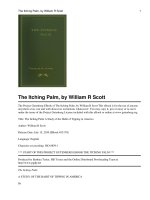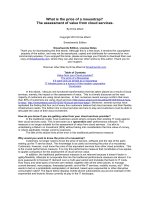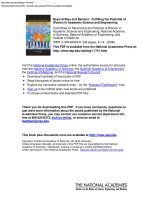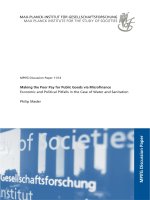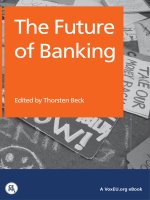The Future Of Water In African Cities pptx
Bạn đang xem bản rút gọn của tài liệu. Xem và tải ngay bản đầy đủ của tài liệu tại đây (13.99 MB, 226 trang )
The Future of Water
in African Cities
Why Waste Water?
Michael Jacobsen, Michael Webster,
and Kalanithy Vairavamoorthy,
Editors
DIRECTIONS IN DEVELOPMENT
Environment and Sustainable Development
The Future of Water in African Cities
The Future of Water
in African Cities
Why Waste Water?
Michael Jacobsen, Michael Webster,
and Kalanithy Vairavamoorthy,
Editors
© 2013 International Bank for Reconstruction and Development / The World Bank
1818 H Street NW, Washington, DC 20433
Telephone: 202-473-1000; Internet: www.worldbank.org
Some rights reserved
1 2 3 4 16 15 14 13
This work is a product of the staff of The World Bank with external contributions. Note that The World
Bank does not necessarily own each component of the content included in the work. The World Bank
therefore does not warrant that the use of the content contained in the work will not infringe on the
rights of third parties. The risk of claims resulting from such infringement rests solely with you.
The findings, interpretations, and conclusions expressed in this work do not necessarily reflect the
views of The World Bank, its Board of Executive Directors, or the governments they represent. The
World Bank does not guarantee the accuracy of the data included in this work. The boundaries, colors,
denominations, and other information shown on any map in this work do not imply any judgment on
the part of The World Bank concerning the legal status of any territory or the endorsement or accep-
tance of such boundaries.
Nothing herein shall constitute or be considered to be a limitation upon or waiver of the privileges
and immunities of The World Bank, all of which are specifically reserved.
Rights and Permissions
This work is available under the Creative Commons Attribution 3.0 Unported license (CC BY 3.0)
Under the Creative Commons Attribution license, you
are free to copy, distribute, transmit, and adapt this work, including for commercial purposes, under
the following conditions:
Attribution—Please cite the work as follows: Jacobsen, Michael, Michael Webster, and Kalanithy
Vairavamoorthy, eds. 2012. The Future of Water in African Cities: Why Waste Water? Directions in
Development. Washington, DC: World Bank. doi:10.1596/978-0-8213-9721-3. License: Creative
Commons Attribution CC BY 3.0.
Translations—If you create a translation of this work, please add the following disclaimer along with
the attribution: This translation was not created by The World Bank and should not be considered an
official World Bank translation. The World Bank shall not be liable for any content or error in this transla-
tion.
All queries on rights and licenses should be addressed to the Office of the Publisher, The World Bank,
1818 H Street NW, Washington, DC 20433, USA; fax: 202-522-2625; e-mail:
ISBN (paper): 978-0-8213-9721-3
ISBN (electronic): 978-0-8213-9722-0
DOI: 10.1596/978-0-8213-9721-3
Cover image: Harare, Zimbabwe. ©Len Abrams, SeasonImages.com
Cover design: Naylor Design, Inc.
Library of Congress Cataloging-in-Publication Data has been requested.
v
Contents
Foreword xiii
Acknowledgments xv
About the Editors xix
Abbreviations xxi
Overview 1
Chapter 1 Africa’s Emerging Urban Water Challenges 15
Africa’s Rapid Urbanization Brings
Opportunities and Threats 16
African Cities Struggle to Provide Access to
Water and Sanitation to Their Current Population 19
Water Demand Increases Even Faster than
Population Growth 24
Water Supply Depends on the Quantity and
Quality of Water in the Catchment 25
Poor Drainage and Flooding Are a Growing Problem 28
These Challenges Are Exacerbated by Climate
Variability, Flooding, and Uncertainty about
the Future 28
Secondary Cities are Equally at Risk but Even
Less Equipped to Manage Complexity 34
vi Contents
Solving the Urban Water Challenge Is Essential
to Achieve Growth and to Reduce Poverty 36
Lack of Data Complicates Finding Solutions 37
The Current Way in Which We View Urban
Water Systems Might Hinder Our Ability to
Respond to Future Challenges 38
Notes 39
Chapter 2 An Integrated Perspective for Urban Water
Management 41
IUWM has a History of Knowledge and Good
Practice 42
The Urban Water Cycle Is One System 43
The Urban Water Cycle Is Closely Linked to the
Watershed 44
Water Should Be Managed across Institutions 45
All Players Should Be Part of the Process 49
Water Should Be Fit for Purpose 51
Diverse Sources Provide Better Water Security 52
Urban Groundwater: Sustaining Water Security
and Increasing Water Treatment Potential 54
Innovative Technologies Can Play a Role 56
Wastewater Might Be Valuable 58
Adaptive Systems Work Best to Cope with
Uncertainty 60
Notes 61
Chapter 3 Assessing Water Management Challenges and
Capacities in African Cities 63
Knowledge and Attitudes to Urban Water
Management Are More Evolved than Its
Practice in Africa 64
Reducing Complexity to Two Dimensions:
IUWM Capacities and Challenges Index 67
You Cannot Manage What You Do Not
Measure: A City Dashboard as a Starting
Point for Dialogue 70
The Spatial Dimensions of a Growing City
Matter to Water Management 75
Contents vii
Climate Change Will Have an Impact on Urban
Water Management 79
Notes 81
Chapter 4 In-Depth Analysis of Water Management
Challenges in Selected Cities 83
Nairobi, Kenya: Dealing with the Gap between
Supply and Demand 84
Mbale, Uganda: A Time-Limited Window of
Opportunity 90
Arua, Uganda: Can Decentralized Solutions
Postpone a Very Large Infrastructure Project? 97
Douala, Cameroon: Addressing Sanitation,
Flooding, and Waste Management 105
Participation of Stakeholders in IUWM:
Experience from Case Studies 109
Notes 112
Chapter 5 Making IUWM Work in African Cities 113
Increase Use of IUWM in Project Planning and
Design in Africa 113
Better Understand Institutional Requirements
and Implications of IUWM 115
Implement Pilot Projects to Demonstrate
IUWM in Practice 117
Promote a Learning Alliance for IUWM 118
Flowing Water in Fluid Cities: IUWM in
Expanding African Cities 122
APPENDIXES 123
Appendix 1 Knowledge, Attitudes, and Practices Survey—
Methodology 125
Appendix 2 Diagnostic of Water Management for 31 Cities
in Africa 139
Appendix 3 Indicators for the 31 Cities Diagnostic 157
Appendix 4 Methodology for Urban Extent Maps 165
References 185
viii Contents
Boxes
2.1 Integration of Water Resource Management, Water
Supply, and Sanitation: Polokwane, South Africa 44
2.2 Watershed Management and Water Supply: Payment
for Ecosystem Services in Heredia, Costa Rica 45
2.3 Integration across Legislative and Strategic
Frameworks: South African Integrated Development Plans 47
2.4 A Holistic Approach to Urban Planning: Indore’s
Slum Network Project 48
2.5 Public Participation in Allocating Scarce Water: The
Eastern Australian Experience 50
2.6 Cascading Use of Water for Urban Agriculture:
Accra, Ghana 51
2.7 Water Fit for Industrial Use: Durban, South Africa 51
2.8 Combining Water Fit for Purpose and Security
through Diversity: Windhoek, Namibia 53
2.9 An Innovative Approach Leads to the Discovery of
the Kimbiji Aquifer, a Potentially Important Water
Supply Source for Dar es Salaam, Tanzania 55
2.10 Decentralized Wastewater Treatment System as
an Effective Technology to Improve Sanitation:
Trapeang Sab Commune, Cambodia 57
2.11 Wastewater as a Source of Energy: Naivasha, Kenya 59
2.12 Flexible Design of Decentralized Wastewater
Treatment and Reuse Systems: Xi’an, China 60
4.1 The Tatu Real Estate Project in Nairobi, Kenya:
An Opportunity to Test the IUWM Approach 89
Figures
1 Urban Water Management Challenges versus
Institutional and Economic Capacities 5
2 Schematic of a Possible Integrated Water Supply and
Sanitation System for a Future Development Area in
Arua, Uganda 8
3 Proposed Staged Development of Alternative Water
Sources in Nairobi, Kenya, 2010 to 2035 9
4 Responses to KAP Survey from Water Operators and
Municipalities in Africa 11
1.1 Trend in Urbanization in Africa 17
1.2 Level of Urbanization and Urban Population Growth
Rates in Africa 17
Contents ix
1.3 Population Living in Slums in Africa 18
1.4 Density of 31 African Cities Compared to Reference Cities 19
1.5 Water Consumption per Capita Supplied by Utility
and Continuity of Piped Water Supply 22
1.6 Coverage of Water Services, by Budget Quintile 23
1.7 Increase in Annual Water Demand (2005 to 2030) 24
1.8 Disappearing Lake Chad: A High-Profile Case of
Diminishing Surface Water Sources, 1972 and 2007 25
1.9 Availability of Fresh Water per Person per Year by
Country in 2007 27
1.10 Buildings at Risk due to Gully Erosion, Omagba, Nigeria 29
1.11 Current and Future Population in African Cities
Exposed to Drought 30
1.12 Water Storage in Africa (m
3
per Capita) 32
1.13 Increased Frequency and Impact of Reported
Disasters in Africa 33
B2.7.1 Dual Benefits of Water Fit for Purpose: Reduced
Consumption of Fresh Water and Reduced
Wastewater Discharge 52
B2.8.1 Water Sources for Windhoek, Namibia 53
B2.9.1 Existing Urban Water Supply and Future
Groundwater Source for Dar es Salaam, Tanzania 56
2.1 Resource Recovery from Wastewater 58
B2.11.1 Lavatory and Wastewater Treatment Plant with
Installed Biogas Generation Facility in Naivasha, Kenya 59
3.1 Issues Included in Current Plans, and Issues African
Leaders Think Should Be Included in Future Plans 65
3.2 Involved Parties in the Consultation Process of
Urban Water Management: From the Municipality
and Utility Viewpoints 66
3.3 Cities in Africa Selected for the Diagnostic 67
3.4 Urban Water Management Challenges versus
Institutional and Economic Capacities 69
3.5 Comparative Indicators for Urban Water Challenges
for 31 African Cities 71
3.6 Illustration of Future Urban Extent for a Mature
City and for a Fast-Growing City 76
3.7 Illustrations of Future Urban Extent for Two Coastal
Cities in Areas Vulnerable to Flooding from Rising
Sea Level 77
x Contents
4.1 Estimated Range of Future Water Demand for
Nairobi, Kenya, 2010 to 2035 85
4.2 Staged Development of Water Resources for
Nairobi, Kenya, 2010 to 2035 86
4.3 Staged Development of Water Resources for
Nairobi, Kenya, 2010 to 2035, for One Alternative
IUWM Solution 86
4.4 Water Resources and Unit Costs for One Alternative
IUWM Solution 87
4.5 Current Population and a Suggested Layout for
Future Growth of Mbale Municipality, Uganda 92
4.6 Staged Development of Water Resources, 2010 to
2035, for IUWM in Mbale, Uganda 93
4.7 Schematic of the Proposed Water Supply and
Sanitation System for Existing Built-up Area in
Mbale, Uganda 94
4.8 Schematic of the Proposed Water Supply and
Sanitation System for a New Planned Development
Cluster in Mbale, Uganda 95
4.9 Map of Arua, Uganda, with Proposed Water
Abstraction Points 99
4.10 Unit Cost and Potential of Surface Water around
Arua, Uganda 99
4.11 Unit Cost for Staged Development of Use of Sources
for IUWM in Arua, Uganda 100
4.12 Current Population and a Suggested Layout for
Future Growth of Arua Municipality, Uganda 101
4.13 Staged Development of Water Resources, 2010 to
2035, for IUWM in Arua, Uganda 102
4.14 Schematic of the Proposed Water Supply and
Sanitation System for a New Planned Development
Cluster in Arua, Uganda 103
A4.1 Initial Landscape 173
A4.2 Influence of Roads: Next-to-Road 173
A4.3 Influence of Roads: Near Road 174
A4.4 Influence of Slope: Slope Ranking 174
A4.5 Excluded Areas: Exclusion Binary Ranking 175
A4.6 Suitability Ranking for Urbanization 175
A4.7 New Area Allocated to Urban Use 176
A4.8 Final Map of Urban Extent for Kumasi, Ghana 176
Contents xi
Tables
1.1 Slum Population as a Share of Urban Population in
Africa and the World 18
1.2 Urban Population with Access to Water Supply and
Sanitation 2000 and 2010 20
1.3 Annual Average Capital Expenditure for African Utilities 21
1.4 Africa’s Urban Population, Number of Cities, and
Percent of Urban Population 35
1.5 Estimated Cost of Droughts and Floods in Kenya 37
3.1 Cities, Water, and Climate Change in 2050:
An Indicator Approach to Understanding the Risk
for 31 Cities 80
4.1 Key Characteristics and Location of Nairobi, Kenya 84
4.2 Key Characteristics and Location of Mbale, Uganda 90
4.3 Key Characteristics and Location of Arua, Uganda 97
4.4 Key Characteristics and Location of Douala, Cameroon 105
4.5 Stakeholders and Participants at the Workshops and
Consultations for the Three Case Studies 110
5.1 Principles of Integrated Management: Evaluative
Questions 115
5.2 Principles of Sustainable Management: Evaluative
Questions 116
A1.1 Water Utilities That Responded to the KAP Survey 129
A1.2 Municipalities That Responded to the KAP Survey 130
A2.1 Cities and Selection Criteria 141
A2.2 Main Data Sources 149
A2.3 Calculation, Definition, and Codification of Intervals 154
A2.4 Variables and Indicators Representing the Challenges
and Capacities of Cities 155
A3.1 Selection of Indicators for the 31 Cities Diagnostic 158
A4.1 Imagery Used to Classify Urban Extent for Each
City and Each Time Period 177
xiii
Foreword
The management of water resources and supply is essential to the devel-
opment and growth of cities. Sustainable resource use and the provision
of quality services to a growing urban population underpins the success
of future cities, enables them to act as poles of economic growth, and is
at the core of social and economic development in an urbanizing world.
The purpose of this book is to contribute to the broader green and inclu-
sive growth ideas of the World Bank, by changing the way urban policy
makers in Africa and project managers from the World Bank and other
international organizations think about urban water management, plan-
ning, and project design.
The city of the future in Africa needs to be designed to accommodate
twice as many people, and we need to plan it now. Traditional approaches
are unlikely to be able to close the gap between supply and demand for
water. Helping practitioners and decision makers in African cities con-
sider a wider range of solutions to secure urban resilience in an uncertain
future will require a concerted effort across sectors and institutions.
Implementing efficient and flexible urban water systems and adopting a
holistic view of all components of the urban water cycle will be essential
if we want to provide environmentally sustainable growth and access to
better services for current and future African communities.
xiv Foreword
Thanks to its flexibility and adaptability to a range of current and
future conditions, Integrated Urban Water Management (IUWM) can be
a powerful tool to provide clean safe water to African urban communi-
ties. It reflects the need to do things differently with the resources and
expertise already at hand. IUWM is by no means a silver bullet that will
solve all of Africa’s urban water problems: the reforms it entails will be
challenging, and its ideas and approaches will require testing on the
ground. But as this book demonstrates, because it proposes to build sys-
tems incrementally and with broad consultation from stakeholders, the
IUWM approach is, by nature, pragmatic and adaptive, and can help build
green and inclusive growth in Africa.
Rachel Kyte
Vice President
Sustainable Development Network
World Bank
Makthar Diop
Vice President
Africa Region
World Bank
xv
Acknowledgments
This report was edited by Michael Jacobsen (Senior Water Resources
Specialist, World Bank), Michael Webster (Senior Water and Sanitation
Specialist, World Bank), and Kalanithy Vairavamoorthy (Director, Patel
School of Global Sustainability, University of South Florida or USF), with
support from Daniel Shemie (Junior Professional Associate, World Bank),
Alvar Closas (Consultant, World Bank), and Meleesa Naughton (Junior
Professional Associate, World Bank). Each of the chapters was prepared
by a group of authors, who in turn have drawn on key source documents
that were commissioned from consultants and World Bank staff specifi-
cally for this work.
Chapter 1—Author: Michael Webster (Senior Water and Sanitation
Specialist, World Bank)
Background material contributed by: Carolina Dominguez Torres
(Consultant, World Bank), Gabrielle Puz (Consultant, World Bank),
Nagaraja Rao Harshadeep (Senior Environmental Specialist, World
Bank), and Asmita Tiwari (Consultant, World Bank)
Chapter 2—Authors: Kalanithy Vairavamoorthy (Director, Patel School of
Global Sustainability, USF), Kebreab Ghebremichael (Senior Research
Fellow, USF), Michael Jacobsen (Senior Water Resources Specialist,
xvi Acknowledgments
World Bank), Jochen Eckart (Research Fellow, USF), Seneshaw Tsegaye
(Research Fellow, USF), and Krishna Khatri (Research Fellow, USF)
Background material contributed by: Robin Bloch (Principal Consultant,
GHK)
Chapter 3—Authors: Michael Jacobsen (Senior Water Resources
Specialist, World Bank), and Alvar Closas (Consultant, World Bank)
Background material contributed by: Alvar Closas (Consultant, World
Bank), Daniel Shemie (Junior Professional Associate, World Bank),
Meleesa Naughton (Junior Professional Associate, World Bank), James
Duncan (Consultant, World Bank), Brian Blankespoor (Environmental
Specialist, World Bank), Ryan Engstrom (Assistant Professor, George
Washington University), and Alyssa McCluskey (Senior Research
Associate, University of Colorado)
Chapter 4—Authors: Michael Jacobsen (Senior Water Resources Specialist,
World Bank), Gabrielle Puz (Consultant), and Daniel Shemie (Junior
Professional Associate)
Background material contributed by: Kalanithy Vairavamoorthy (Director,
Patel School of Global Sustainability, USF), Kebreab Ghebremichael
(Senior Research Fellow, USF), Jochen Eckart (Research Fellow, USF),
Seneshaw Tsegaye (Research Fellow, USF), Krishna Khatri (Research Fellow,
USF), Barbara Anton (Project Coordinator, ICLEI—Local Governments for
Sustainability), Ralph Philip (Project Officer, ICLEI), Murray Biedler
(Consultant, ICLEI), João Rabaca (Consultant, ICLEI), Harrison Mutikanga
(Manager, National Water and Sewerage Corporation or NWSC, Uganda),
Joshua Oyieko (Consultant, ICLEI), Rose Kaggwa (Manager, NWSC), and
Frank Kizito (Decision-Support Systems Manager, NWSC)
Chapter 5—Authors: Michael Jacobsen (Senior Water Resources Specialist,
World Bank) and Michael Webster (Senior Water and Sanitation
Specialist, World Bank)
Appendixes—Authors: Appendix 1: Alvar Closas (Consultant, World
Bank), Dan Schemie (Junior Professional Associate, World Bank), Michael
Jacobsen (Senior Water Resources Specialist, World Bank). Appendix 2:
Alvar Closas (Consultant, World Bank), Michael Jacobsen (Senior Water
Resources Specialist, World Bank), Meleesa Naughton (Junior Professional
Associate, World Bank). Appendix 3: Alvar Closas (Consultant, World
Bank), Michael Jacobsen (Senior Water Resources Specialist, World
Bank), Meleesa Naughton (Junior Professional Associate, World Bank).
Acknowledgments xvii
Appendix 4: James Duncan (Consultant, World Bank), Brian Blankespoor
(Environmental Specialist, World Bank), Ryan Engstrom (Assistant
Professor, George Washington University), and Christopher Marques
(Consultant, World Bank)
This work was made possible by the financial contribution of the
Water Partnership Program (WPP) ( />wpp). The author team was inspired and supported throughout by Jamal
Saghir (Director, Africa Sustainable Development Department, World
Bank), Marianne Fay (Chief Economist, Sustainable Development
Network, Wo rld Bank), José Luis Irigoyen (Director, Transport, Water,
Information and Communication Technology Department, World Bank),
Julia Bucknall (Manager, Water Anchor, World Bank), Ashok Subramanian
(who initially proposed this Economic and Sector Work as former man-
ager, Africa Water Resources, World Bank), Jonathan Kamkwalala (Manager,
Africa Water Resources, World Bank), Junaid Kamal Ahmad (former
Manager, Africa Region Urban and Water Unit, or AFTUW, World Bank),
Alex Bakalian (Acting Sector Manager, AFTUW, World Bank), Idah
Pswarayi-Riddihough (Sector Manager, Environment and Natural
Resources Management, Africa Region, World Bank), and Jaehyang So
(Manager, Water and Sanitation Program, World Bank).
Invaluable support for maps and databases was provided by Brian
Blankespoor (Environmental Specialist, World Bank) and Jim Duncan
(Consultant, World Bank), who were in turn supported by Ryan Engstrom
(Assistant Professor, George Washington University) and Christopher
Marques (Consultant, World Bank). The comprehensive and rigorous
editorial support of Hilary Gopnik was very much appreciated. Meghana
Kandekhar provided design support for graphics and Kristine Kelly for
copyediting. Chonlada Sae-Hau and Immaculate Bampadde provided
administrative assistance.
The authors would like to acknowledge the importance of the contri-
butions of peer reviewers. External peer reviewers include Muchadeyi
Masunda (His Worship the Mayor of Harare, Zimbabwe), Jean Pierre
Mbassi (Secretary General, United Cities and Local Governments of
Africa, or UCLGA), Sylvain Usher (Secretary General, African Water
Association), Jay Bhagwan (Director, Water Use and Waste Management,
Water Research Commission, South Africa), and Mark Pascoe (CEO,
International Water Center, Australia). Internal peer reviewers include
Daniel A. Hoornweg (Lead Urban Specialist, World Bank), Dominick
Revell de Waal (Senior Economist, World Bank), David Michaud (Senior
xviii Acknowledgments
Water and Sanitation Specialist, World Bank), Marcus J. Wishart (Senior
Water Resources Specialist, World Bank), and Sudipto Sarkar (Sector
Leader, World Bank).
A large number of colleagues and other professionals have contributed
their advice and suggestions to the report. For the Nairobi case studies we
thank Wambui Gichuri (Principal Regional Team Leader, Water and
Sanitation Program, World Bank), Rafik Hirjii (Senior Water Resources
Specialist, World Bank), Patrick Mwangi (Senior Water and Sanitation
Specialist, World Bank), Pascaline Ndungu (Consultant, World Bank),
Christian Peter (Senior Natural Resources Management Specialist, World
Bank), Andreas Rohde (Senior Sanitary Engineer, World Bank), Rosemary
Rop (Water and Sanitation Specialist, World Bank), and Johannes Zutt
(Country Director, World Bank). For the Arua and Mbale case studies we
thank Mukami Kariuki (Sector Leader, World Bank), Samuel Mutono
(Senior Water and Sanitation Specialist, World Bank), Ahmadou
Moustapha Ndiaye (Country Manager, World Bank), Halla Qaddumi
(Consultant, World Bank), Adolf Spitzer (Senior Infrastructure Planner,
NWSC), and Berina Uwimbabazi (Water Resources Management
Specialist, World Bank).
This study would not have been possible without access to and inter-
pretation of data provided by Alexander Danilenko (International
Benchmarking Network for Water and Sanitation Utilities) and Rosemary
Rop (Water Operators’ Partnership—Africa, Water and Sanitation
Program). In addition to the background material mentioned for each
chapter, contributions to unpublished background papers and suggestions
and comments on early drafts and ideas were provided by a large number
of colleagues and professionals, including Ger Bergkamp (Director,
International Water Association, or IWA), Greg Browder (Lead Water and
Sanitation Specialist, World Bank), Uwe Deichman (Senior Environmental
Specialist, World Bank), Martin Gambrill (Senior Water Engineer, World
Bank), Abhas Jha (Lead Urban Specialist, World Bank), Felix Masangai
(Head of Program, Ministry of Finance, Mozambique), Abel Mejia
(Consultant, World Bank), David Michaud (Senior Water and Sanitation
Specialist, World Bank), Soma Ghosh Moulik (Senior Water and
Sanitation Specialist, World Bank), Ngoni Mudege (Consultant, Water
and Sanitation Program), Paul Reiter (Executive Director, IWA), Matthijs
Schuring (Operations Analyst, World Bank), Somnath Sen (Consultant,
World Bank), Sarah Tibatemwa (Director, IWA Africa), Hyoung Wang
(Economist, World Bank), and Tony Wong (Centre for Water Sensitive
Cities, Monash University, Melbourne, Victoria, Australia).
xix
Michael Jacobsen is currently a Senior Water Resources Specialist with
the Water Anchor of the World Bank. He has published on water and
climate change and is working with the interface between water
resources, water services, economic growth, and urban planning. Prior to
joining the World Bank in 2009, he was Chief Economist at a major engi-
neering consultancy firm responsible for a number of environmental
infrastructure projects and publishing on water tariffs (for the European
Bank for Reconstruction and Development) and economic analysis of
water projects (for the International Water Association). Mr. Jacobsen
holds an MA in Economics from the University of Copenhagen.
Michael Webster is a Senior Water and Sanitation Specialist in the Africa
Region of the World Bank. He is located in Zimbabwe and leads opera-
tions in Malawi, Zambia, and Zimbabwe in the water and urban sectors.
During his 12 years at the Bank, he has worked on more than 40 opera-
tions in Africa, Asia, and Europe, and has lead analytical work on public
finance and water. Prior to joining the Bank, he worked as an engineer and
project manager in South Africa and the United Kingdom. Mr. Webster
holds a BSc in Civil Engineering from the University of Cape Town, an
MSc in Engineering from Loughborough University, and an MPP from
Princeton.
About the Editors
xx About the Editors
Kalanithy Vairavamoorthy is an expert on urban water issues who has
worked to create clean and sustainable water and sanitation systems
through programs for the United Nations Educational, Scientific and
Cultural Organization and the European Union. He currently directs the
Patel School of Global Sustainability at the University of South Florida.
In his career, Mr. Vairavamoorthy has led groups of researchers studying
the future of sustainable water systems for cities and how urban areas
might respond to water issues in the face of climate change and popula-
tion growth. His current research includes development of new tech-
niques for the flexible design of urban water supply systems operating
under uncertainties associated with global change; application of optimi-
zation techniques for the operation and maintenance and life-cycle man-
agement of urban water systems; and development of risk assessment
approaches for the design of sustainable urban water systems operating in
the “city of the future.”
xxi
AfDB African Development Bank
AfWA African Water Association
AICD Africa Infrastructure Country Diagnostic
AMCOW African Ministers’ Council on Water
BSWC Borno State Water Corporation, Nigeria
BWB Blantyre Water Board, Malawi
CSO Country status overview
CWSC Chipata Water and Sewerage Company, Zambia
DEWATS Decentralized wastewater treatment systems
DWAF Department of Water Affairs, South Africa
EU European Union
GDP Gross domestic product
GHK GHK Consulting Limited
IBNET International Benchmarking Network for Water and
Sanitation Utilities
ICLEI International Council for Local Environmental
Initiatives
IDP Integrated Development Plan, South Africa
ISO International Organization for Standardization
IUWM Integrated urban water management
IWA International Water Association
IWRM Integrated water resources management
Abbreviations
xxii Abbreviations
KAP Knowledge, attitudes, and practices
KIWASCO Kisumu Water and Sewerage Company, Kenya
LAC Latin America and Caribbean
LWSC Lusaka Water and Sewerage Company, Zambia
Ml Megaliter (one million liters)
MWSC Mombasa Water and Sewerage Company, Kenya
NGWRP New Goreangab Water Reclamation Plant, Namibia
NWASCO Nairobi City Water and Sewerage Company, Kenya
NWSC National Water and Sewerage Corporation, Uganda
OECD Organisation for Economic Co-operation and
Development
OGWRP Old Goreangab Water Reclamation Plant, Namibia
ONEA Office Nationale des Eaux et Assainissement,
Burkina Faso
PAD Project appraisal document
SAT Soil aquifer treatment
SDE Sénégalaise des Eaux, Senegal
SONEB Société Nationale des Eaux du Benin, Benin
SNP Slum Network Project, India
SWITCH Sustainable Water Management Improves Tomorrow’s
Cities Health
TdE Togolaise des Eaux, Togo
UCLGA United Cities and Local Governments of Africa
UNDESA United Nations Department of Economic and Social
Affairs
UNDP United Nations Development Programme
UNEP United Nations Environment Programme
UNESCO United Nations Educational, Scientific and Cultural
Organization
UNESCO-IHE United Nations Educational, Scientific and Cultural
Organization, Institute for Water Education
UNESCO-IHP United Nations Educational, Scientific and Cultural
Organization, International Hydrological Programme
UN-HABITAT United Nations Human Settlements Programme
UNICEF United Nations Children’s Fund
USF University of South Florida
WBI World Bank Institute
WHO World Health Organization
WSP Wastewater stabilization pond
WSS Water supply and sanitation
1
The overall goal of this book is to change the way urban policy makers
think about urban water management, planning, and project design in
Africa. African cities are growing quickly, and their current water man-
agement systems cannot keep up with growing demand. It will take a
concerted effort on the part of decision makers across sectors and institu-
tions to find a way to provide sustainable water services to African city
dwellers. This book argues that these complex challenges require innova-
tive solutions and a management system that can work across institu-
tional, sectoral, and geographic boundaries. A survey conducted for this
analysis shows that African city leaders and utility operators are looking
for ways to include a broader range of issues—such as water resources
management, flood and drought preparation, rainwater harvesting, and
solid waste management—than previously addressed in their water man-
agement plans. This book argues that integrated urban water manage-
ment (IUWM) will help policy makers in African cities consider a wider
range of solutions, understand water’s interaction with other sectors, and
secure resilience under a range of future conditions.
IUWM seeks to develop efficient, flexible, urban water systems by
adopting a holistic view of all components of the urban water cycle
(water supply, sanitation, stormwater management) in the context of the
wider watershed. IUWM is formulated in response to the complexity of
Overview


